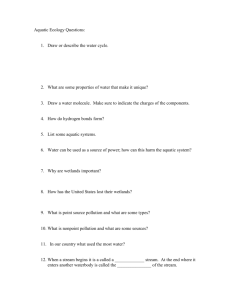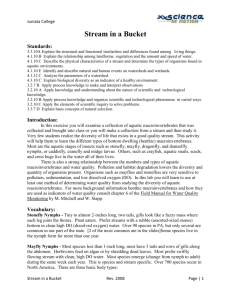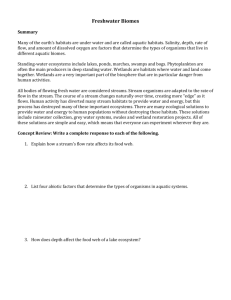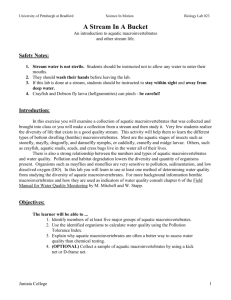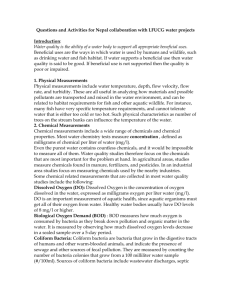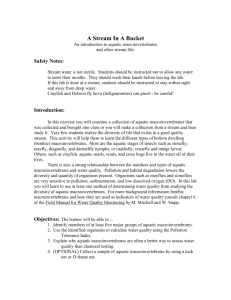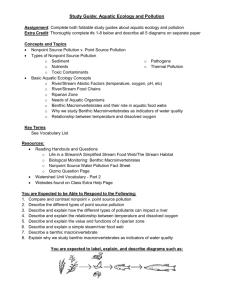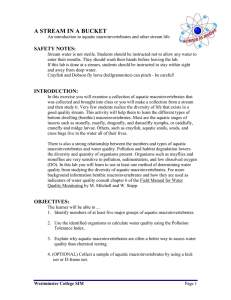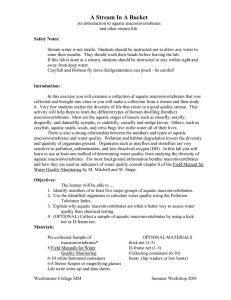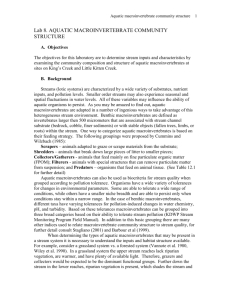Stream in a Bucket
advertisement
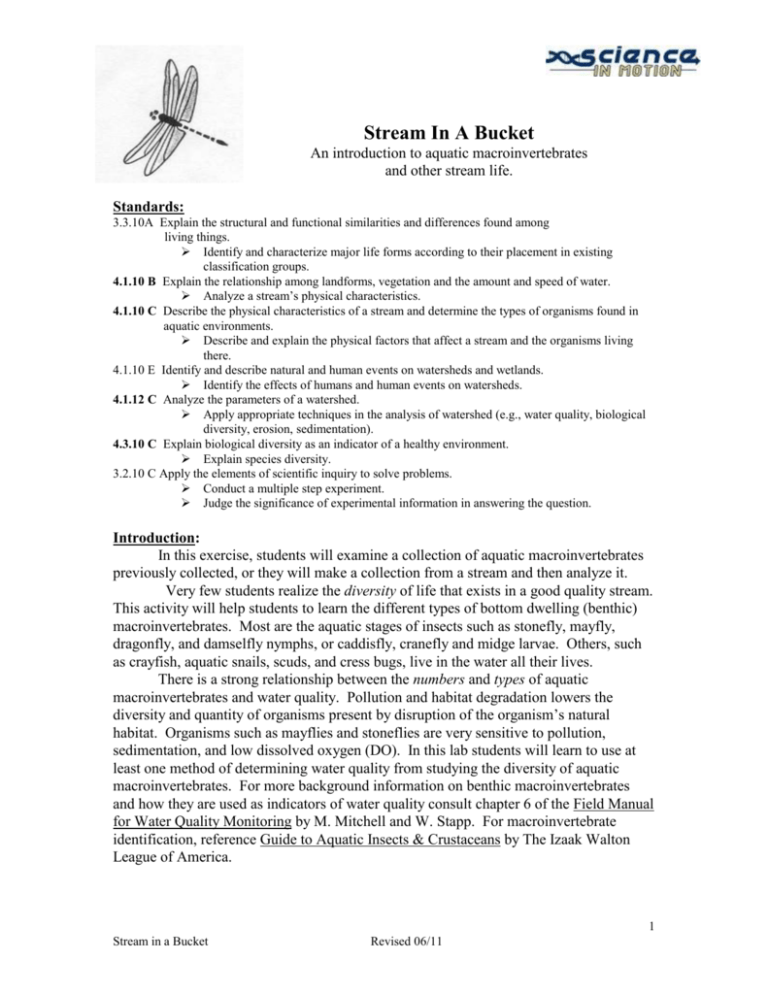
Stream In A Bucket An introduction to aquatic macroinvertebrates and other stream life. Standards: 3.3.10A Explain the structural and functional similarities and differences found among living things. Identify and characterize major life forms according to their placement in existing classification groups. 4.1.10 B Explain the relationship among landforms, vegetation and the amount and speed of water. Analyze a stream’s physical characteristics. 4.1.10 C Describe the physical characteristics of a stream and determine the types of organisms found in aquatic environments. Describe and explain the physical factors that affect a stream and the organisms living there. 4.1.10 E Identify and describe natural and human events on watersheds and wetlands. Identify the effects of humans and human events on watersheds. 4.1.12 C Analyze the parameters of a watershed. Apply appropriate techniques in the analysis of watershed (e.g., water quality, biological diversity, erosion, sedimentation). 4.3.10 C Explain biological diversity as an indicator of a healthy environment. Explain species diversity. 3.2.10 C Apply the elements of scientific inquiry to solve problems. Conduct a multiple step experiment. Judge the significance of experimental information in answering the question. Introduction: In this exercise, students will examine a collection of aquatic macroinvertebrates previously collected, or they will make a collection from a stream and then analyze it. Very few students realize the diversity of life that exists in a good quality stream. This activity will help students to learn the different types of bottom dwelling (benthic) macroinvertebrates. Most are the aquatic stages of insects such as stonefly, mayfly, dragonfly, and damselfly nymphs, or caddisfly, cranefly and midge larvae. Others, such as crayfish, aquatic snails, scuds, and cress bugs, live in the water all their lives. There is a strong relationship between the numbers and types of aquatic macroinvertebrates and water quality. Pollution and habitat degradation lowers the diversity and quantity of organisms present by disruption of the organism’s natural habitat. Organisms such as mayflies and stoneflies are very sensitive to pollution, sedimentation, and low dissolved oxygen (DO). In this lab students will learn to use at least one method of determining water quality from studying the diversity of aquatic macroinvertebrates. For more background information on benthic macroinvertebrates and how they are used as indicators of water quality consult chapter 6 of the Field Manual for Water Quality Monitoring by M. Mitchell and W. Stapp. For macroinvertebrate identification, reference Guide to Aquatic Insects & Crustaceans by The Izaak Walton League of America. 1 Stream in a Bucket Revised 06/11 Science In Motion Juniata College Guiding Questions: Given one day only to test the water quality of a stream, which do you feel would be the best water quality indicator: abiotic factors or biotic factors? Why? Vocabulary: Larva - The immature, wingless, and often wormlike feeding form that hatches from the egg of many insects. It passes through several molts getting larger with each molt. It is finally transformed into a pupa or a chrysalis from which the adult emerges. Larvae often have the following differences from their adult form: The larva's appearance is generally very different from the adult form, a larva often has unique structures and larval organs that do not occur in the adult form, a larva's diet can be considerably different from its adult form, and larvae are frequently adapted to environments separate from adults.1 Nymph - The immature form of insects that do not pass through a pupal stage. Nymphs usually look like miniature adults, but they lack fully developed wings and sex organs. Nymphs molt several times. Later molts produce growing wings and sexual organs eventually becoming adults. Incomplete metamorphosis-a term used to describe the mode of development of certain insects that includes three distinct stages: the egg, nymph, and the adult stage, or imago. These groups go through gradual changes; there is no pupal stage. Complete metamorphism-a term applied to insect groups to describe the specific kind of insect development which includes four life stages: an embryo or egg, a larva, a pupa, and an imago or adult. Biodiversity-The variation of life forms within a given ecosystem, biome, or the entire earth. Biodiversity is often used as a measure of the health of biological systems. Macroinvertebrate -an invertebrate that is large enough to be seen without the use of a microscope. Pupa-the stage of metamorphosis in which the organism reorganizes into a completely new body form.2 Materials: Pre-collected sample of macroinvertebrates 8 Field Manuals for Water Quality Monitoring 10-12 white-bottomed containers 3 Stereo Scopes or magnifying glasses Lab write-up and data sheets Macroinvertebrate identification cards PA fishing license if you are 16 or older OPTIONAL MATERIALS Kick net (1-3) D-frame net (1-3) Collecting containers (6-10) boots (hip waders or low boots) Aquatic Insect Slides Slide projector aquatic insects CD “dead bugs” 2 Stream in a Bucket Revised 06/11 Science In Motion Juniata College Safety Notes: 1. Stream water is not sterile and may contain harmful substances; please take appropriate precautions. 2. Crayfish and Dobson fly larva (hellgrammites) can pinch - be careful! 3. If this lab is done at a stream, students should be instructed to stay within sight and away from deep water. Prelab Questions: Procedure: 1. Take notes on slides and/or discussion of the characteristics of the major groups of aquatic macroinvertebrates and how to recognize them. 2. OPTIONAL - Use kick net and/or D-frame net to collect aquatic macroinvertebrates. 3. Move to one of the numbered samples. 4. Use your Field Manual for Water Quality Monitoring (pages 129-133), the macroinvertebrate identification sheet, or your notes to identify, get an approximate count, and classify according to pollution tolerance the organisms in your sample. 5. Record your results on the Macroinvertebrate Sample data sheet. 6. Move to another numbered sample and repeat steps 4 and 5. 7. When you are finished with all of the samples, use the information from your data sheet to calculate the Pollution Tolerance Index. Other methods, such as Sequential Comparison Index or the Diversity Index (page 126-133) can also be used to measure water quality. 8. Complete the discussion questions. 3 Stream in a Bucket Revised 06/11 Science In Motion Juniata College Macroinvertebrate Sample Data Sheet See pages 130-133 in the Field Manual for Water Quality Monitoring. Stream Sampled - _________________________ Date- __________________ Location - ________________________________ Substrate - ______________ Organisms from Group 1 Organisms from Group 2 ______________________________ ______________________________ ______________________________ ______________________________ ______________________________ ______________________________ ______________________________ ______________________________ ______________________________ ______________________________ ______________________________ ______________________________ ______________________________ ______________________________ Organisms from Group 3 Misc. Vertebrates ______________________________ ______________________________ ______________________________ ______________________________ ______________________________ ______________________________ ______________________________ ______________________________ Calculate Pollution Tolerance Index Cumulative Index Value 23 and above 17 - 22 11 - 16 10 or less Stream Quality Assessment = = = # Group 1 ____ X 3 = _____ Excellent Good Fair Poor # Group 2 ____ X 2 = _____ # Group 3 ____ X 1 = _____ _____________________________ Cum. Index Value = ________ Stream Quality Assessment ________________________ 4 Stream in a Bucket Revised 06/11 Science In Motion Juniata College Reflection and Application 1. What habitat requirements of an organism might make it “pollution-sensitive?” 2. List five organisms that are pollution-sensitive (pollution-intolerant). 1. __________________ 2. __________________ 4. __________________ 5. __________________ 3. __________________ 3. Why are aquatic macroinvertebrates often better indicators of water quality than chemical testing? 4. Take the following data, collected from Laurel Run on October 4, 1995, and calculate a Pollution Tolerance Index, Cumulative Index Value, and give a Stream Quality Assessment: 5 green caddisflies 7 crayfish 1 hellgrammite 3 tan midge larva 2 swimming mayflies 1 aquatic worm Cumulative Index Value = _______ Water Quality Assessment = ___________ 5. What stream substrate usually has the most diverse macroinvertebrates? 6. Explain how to tell a mayfly nymph from a stonefly nymph. 7. Would you expect to see different body structures with in a family in a riffle versus a pool? Why or why not? 5 Stream in a Bucket Revised 06/11
